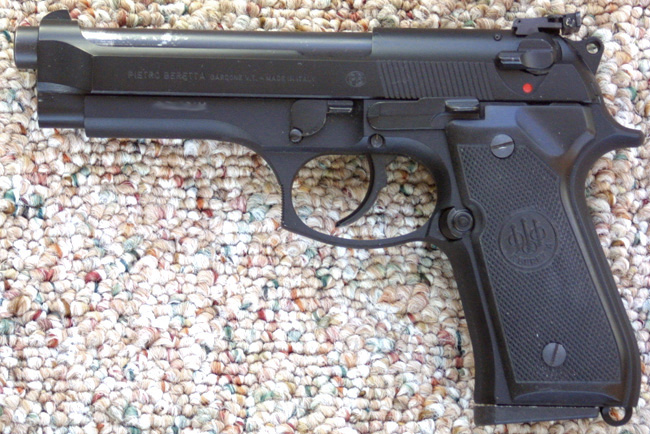The Enduring Legacy of the Pistol/Carbine Combo
One of the most practical and pragmatic ideas from a most practical and
pragmatic time. The pistol carbine combo idea dates back at least to the
cowboy era and possibly to the dawn of the metallic cartridge. It is an
idea that was lost for a while when men became fascinated by the power of
the new smokeless powders, and what could be done with them in bottle neck
cases and long barrels. The word carbine has taken on different meanings over
the years, but the one consistent factor is that these are small, light, shoulder
fired arms. Originally they were simply standard rifles cut down a bit to
make them easier for men to handle on horseback. In black powder days, you
could use the same ball and powder for pistol, carbine and long gun alike,
using different measures of powder if required. The introduction of the metallic
cartridge began to change this. Rifles and pistols, even those with the
same bore, could now need different ammunition.
All of the early metallic cartridges used straight
walled cases like a modern day pistol cartridge; bottle necked cartridges
did not come on the scene until near the turn of the century. Pistols
started to become very light compared to their rifle counterparts, and
rifle cartridges began to get very much longer and more powerful than
pistol cartridges. Some of these straight walled rounds could get very long
indeed, like the 45-70 or 45-120. The guns that fired these "buffalo rounds"
were heavy, single shot pieces, used to knock down animals at long range.
They were just what the long range hunter wanted, but their size, weight,
and single shot made them unsuitable for defense. There was the pistol,
of course, but pistols are much more difficult to fire than rifles, and
even in skilled hands, the shorter barrel and sight radius greatly reduce
range and accuracy. The obvious solution was to chamber the new lever actions,
which already chambered short cartridges, for the same round that pistols
fired. These guns were not considered to be carbines, they were simply rifles.
A shortened buffalo gun would have been called a carbine in those days,
while the smaller lighter lever gun would have been considered a rifle; Weird.
The most common combo cartridge was the 44-40, but there were many others.
This was by far the way most Americans armed them selves in those days.
The situation changed with the introduction of
smokeless powder, bottle necked cartridges, improvements in metallurgy,
and the bolt action rifle. These developments made rifle cartridges of
much more power possible, but did not yet make much of an improvement
in the performance of the pistol. Smokeless powder was considerably more
powerful than the old black powder, and it's burning rate could be adjusted
by altering the size of the granules, so that it could be made to burn
slowly enough for great velocity to be wrung out of longer barrels. A bottle
necked cartridge, because it is fatter, can hold more powder than a straight
walled cartridge. Straight walled cartridges can be made longer to hold
more powder by lengthening them, but this can only be taken so far. After
a cartridge reaches a certain length, it is no longer possible for all
of the powder to be ignited at once by the primer. There is also the matter
of velocity versus pressure. Attainable velocity in a straight walled cartridge
is limited by the speed and pressure directly produced by the burning of
the powder. Even in modern guns, only so much pressure may be withstood.
A bottle necked cartridge constricts where the bullet is seated, causing
the velocity of the gasses generated to increase. This is a basic law of
physics, that in a constriction, pressure is reduced and velocity is increased.
At the time of their development, these guns were in great demand, and the
idea of the straight walled rifle cartridge was looked at with contempt and
nostalgia. Because of their shorter barrels, and difficulties in finding
a satisfactory means of seating bottle neck cartridges in them, pistols got
no such performance boost from the new developments.
This was how the situation remained until the after
the First World War. At that time it was found that for close in fighting
in the trenches, and urban areas, and for police work, a pistol was not
enough, but a rifle was too much. This was first addressed by the excellent
Thompson, the first submachine gun. There had been machine guns in the trenches,
and they had changed the face of warfare, but they had been large heavy
weapons which required crews, and were mounted on tripods in fixed locations.
The Thompson was made small and light enough to be carried and fired by
one man, because it was chambered for a pistol cartridge rather than a rifle
cartridge, thus the designation submachine gun. The gun was introduced too
late for the war, but it would have a chance later on when another world
war broke out. The Second World War is where the submachine gun came into
it's own. Every major power involved used them. They had all endured the
same experiences in the first war, and had all come to the same conclusions
about close in fighting. Though submachine guns were issued, most troops
still used full powered rifles. In the U.S. the first modern carbine (the
M-1 Carbine) was developed. I call this the first
modern carbine, because it was not designed as a submachine gun, although
a full auto version was later made. Where the machine gun was made to lay
down a field of fire, the carbine went back to the old idea of a light
handy gun for aimed deliberate fire. This gun was issued as a replacement
for the pistol, to be issued to non combatants. It was light, handy, and
easy to fire. The submachine gun idea, and the idea of a personal weapon
designed to lay down a high volume of fire, were to be taken a step further
in the development of the assault rifle, but that is another story. The
military has essentially abandoned the carbine, and submachine gun except
for very specialized operations, but civilians and the police are once again
beginning to embrace it.
Present interest in carbines and in the pistol/carbine
combo may have begun after the Second World War. At that time there were
many men returning from the service, and they were all familiar with firearms.
There were a number of surplus weapons available including many M-1 Carbines.
The carbines were light, and easy to shoot, which was what they were
designed to be. These guns became so popular that they inspired Bill
Ruger and some others to design small, handy guns along the same lines.
The famous Ruger .44 magnum Carbine was one of these. This was a four
shot, semi auto that was just the ticket for brush hunters, and for those
who already possessed a .44 handgun. A number of lever action rifles were
introduced, or reintroduced, which fired revolver cartridges. All of these
guns had in common the virtues of lightness, ease of use, and economy,
both in the weapon itself and in the ammunition used.
Even the most powerful pistol cartridges produce
little kick in a long gun. The magnum cartridges, with their heavier bullets,
and slower burning powders, realized great increases in energy out of the
longer barrels. These gains were sufficient to turn a defensive pistol
cartridge into a suitable hunting round. In the case of the .357, and .44
Magnum, double the energy can be achieved in standard loads, more than this
in custom handloads. The handloader, is especially favored by the carbine,
because the long arm's extra strength will allow the use of loads which could
not be safely fired in a pistol, increasing the power of the carbine even
more. This increase is so great that there is even an initiative to replace
the shotgun in police cruiser use with the carbine in some departments. For
the police and civilian shooter alike, the carbine virtues of being quick
on target, and being able to deliver quick follow up shots, make them superb
defensive, or even offensive weapons. No pistol can match the power of a
similarly chambered carbine, nor can a pistol achieve the accuracy or follow
up shot speed of the longer gun. The only place were the pistol is not at
a disadvantage is in very close (arms length) encounters, where the carbine
becomes cumbersome.
Besides it's light weight, and ease of use (also
known as fun), the carbine is very cheap to shoot. A pistol round costs
less than half of what a rifle round sells for. The cost advantage can
be even greater for the handloader. I personally reload, and I can load
up a .357 round for a little more than the cost of a .22 (less if it is
a premium .22 round). The ballistic advantage given by the longer barrel
is less pronounced in semi auto rounds (.45, and 9mm) because of their faster
powders, and smaller case capacities, but it is there, and the advantages
of longer sighting radius, lessened kick, and faster follow up still apply.
Another advantage of the carbine comes when it
is used in concert with a pistol chambered for the same cartridge, and
it is an advantage with which the old time cowboy was very familiar; this
is the need to carry only one type of ammunition for both guns. The handloader
has the chance to work up special loads using heavier bullets and slower powders
to take maximum advantage of the carbines longer barrel, but this will make
the rounds somewhat less suitable for pistol use. It is also possible to
load rounds which can not be fired safely in the smaller, more delicate pistol,
but this would defeat the combo idea, since this would make these cartridges
rifle only rounds. Rounds loaded to this level should be specially marked
and segregated so that they will not cause a memorable, but unpleasant experience
in a pistol. A final advantage that many, but not all, carbines have over
their pistol counterparts, is a larger magazine capacity. In the case of
the Ruger .44 Magnum, the capacity of four is actually less than the six
that most revolver can hold, but as a rule, the carbines can hold eight
to twelve rounds, depending upon cartridge and barrel length. the highest
capacity carbine of which I am aware is the excellent Calico, which will hold 100(!!) rounds of 9mm. The
pistol version of this fine gun is designed to
use a magazine which holds a mere 50, although both guns can use either
magazine. A table showing the ballistic advantage conferred upon the carbine
is below. I have not shown special loads but merely the standard ones. Special
loads can enhance the carbines performance over the pistol by an even more
significant amount.
| ARM | Caliber | Barrel | Weight | Velocity | Energy |
| Pistol | .44 Magnum | 8 3/8" | 240 | 1180fps | 775fp |
| Carbine | .44 Magnum | 18" | 240 | 1740fps | 1650fp |
| ARM | Caliber | Barrel | Weight | Velocity | Energy |
| Pistol | .357Magnum | 4" | 158 | 1235fp | 535fp |
| Carbine | .357 Magnum | 18" | 158 | 1830fps | 1175fp |
| ARM | Caliber | Barrel | Weight | Velocity | Energy |
| Pistol | .45 A.C.P. | 5" | 230 | 842fps | 355fp |
| Carbine | .45 A.C.P. | 18" | 230 | 1092fps |
440fp |
| ARM | Caliber | Barrel | Weight | Velocity | Energy |
| Pistol | 9mm | 4" | 125 | 1110fps | 340fp |
| Carbine | 9mm | 18" | 125 | 1242fps | 430fp |
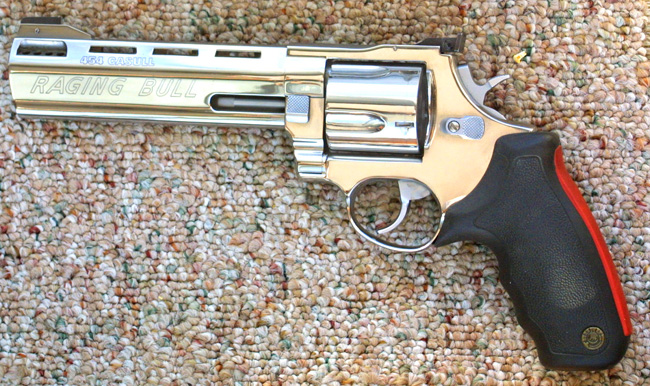
|

|
The 454 was, for a few years, the most powerful handgun cartridge, and is as powerful as many rifle cartridges. It is still a round to be reckoned with, and probably has more power than one would ever want, except under the most trying circumstances. I can carry the carbine with my Raging Bull pistol, in 454, or with either (or both) of my single action 45 Long Colt revolvers. The carbine loads 45 LC in the time honored fashion, through the side loading gate. The longer 454 cartridges need to be loaded through a separate gate towards the front of the tubular magazine, as with some models of 22 rifles. At any rate, whether going traditionally armed with the 45 LC, or taking advantage of the power that today's powders and metallurgy permit with the 454, these are great guns for use in hunting, shooting up the woods, or to use for a day of target practice. The old cowboys would have loved them.
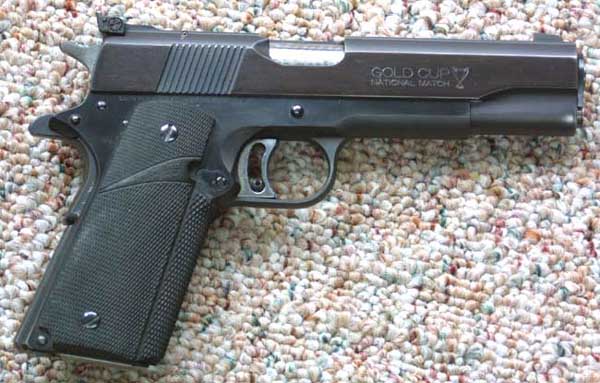 .45 A.C.P.
.45 A.C.P.
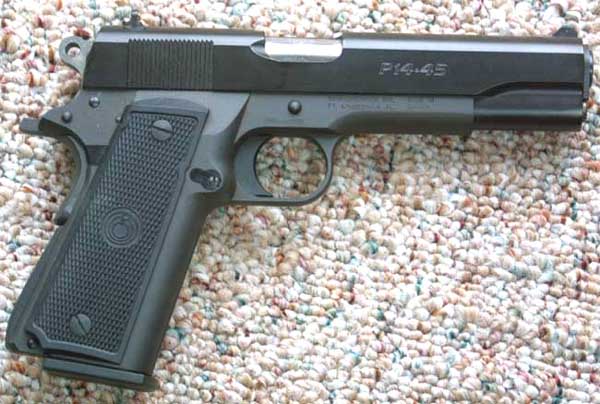 .45 A.C.P.
.45 A.C.P.
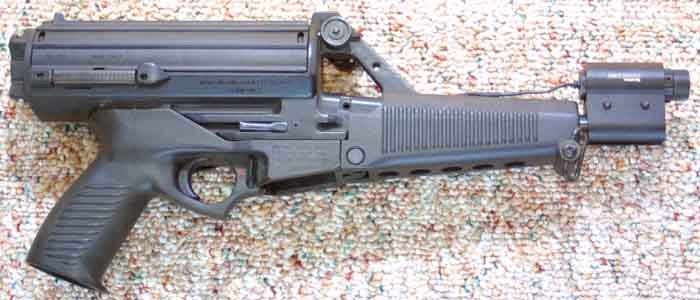 9mm
9mm
 9mm
9mm
A great new addition to the line of pistol carbine combos is made possible by the introduction of the Beretta CX Firestorm. This series of carbines takes the same magazines as the Beretta series of pistols, allowing for complete compatibility. A 9mm version is available for compatibility with the M-92 series of pistols. I posses the 40 S&W variant, for mating with my Beretta M-96 pistol.
 .22 Rimfire
.22 Rimfire
 .22 Rimfire
.22 Rimfire
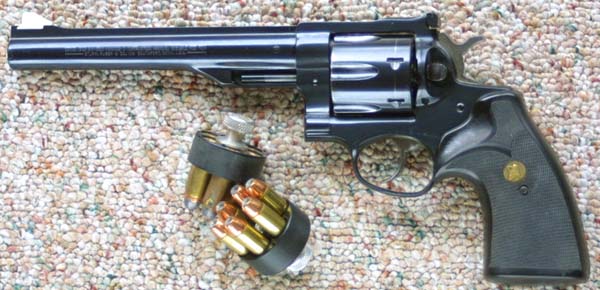 .44 Magnum
.44 Magnum
 .357 Magnum
.357 Magnum
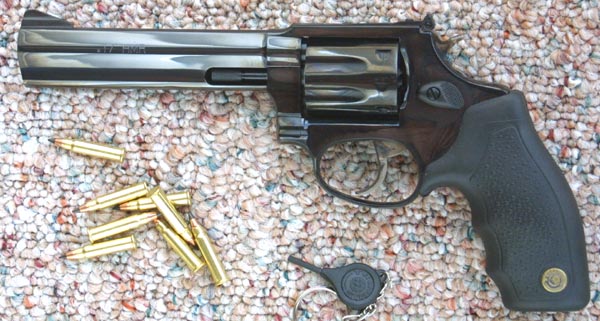 17 HMRF
17 HMRF
The emergence of a number of 410 shot-shell pistols, has opened the door to having a pistol/long-arm combo in this gauge.
Oddball Combos
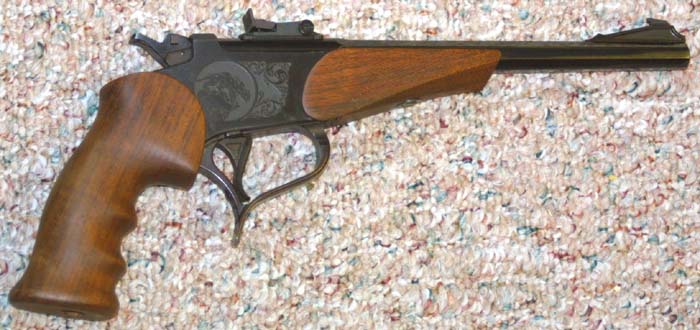 It is possible to put together some pretty odd combinations using
the Thompson Contender and its rifle caliber barrels.
I presently have .357, .44 mag, .22, 410, 30-30, and .223 barrels for this
gun, and I may consider, using this pistol as a companion piece for the
similarly chambered rifles. It is also possible to get a pistol from AMT
which fires the .30 Carbine round. I would not
bother doing this, as I consider the .357 to be a better round out of either
the pistol or carbine. Fans of semi autos may like the idea of a .30 carbine
semi auto pistol, and carbine as opposed to the .357 lever gun and revolver.
Of course, the Contender is also available in the full range of pistol
calibers, so that it, too, could act as a companion piece to many of the
carbines out there.
It is possible to put together some pretty odd combinations using
the Thompson Contender and its rifle caliber barrels.
I presently have .357, .44 mag, .22, 410, 30-30, and .223 barrels for this
gun, and I may consider, using this pistol as a companion piece for the
similarly chambered rifles. It is also possible to get a pistol from AMT
which fires the .30 Carbine round. I would not
bother doing this, as I consider the .357 to be a better round out of either
the pistol or carbine. Fans of semi autos may like the idea of a .30 carbine
semi auto pistol, and carbine as opposed to the .357 lever gun and revolver.
Of course, the Contender is also available in the full range of pistol
calibers, so that it, too, could act as a companion piece to many of the
carbines out there. 